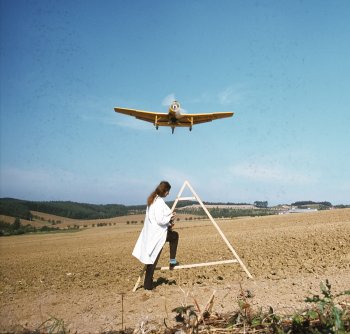Výstava v Komunikačním prostoru Školská 28 se vrací do osmdesátých let. Nalezený archiv fotografií JZD Slušovice přináší svědectví o jedinečném hospodářském fenoménu i o tehdejší propagační fotografii. Představuje několik prací, které nabízejí nový smysl nalezeným diapozitivům JZD Slušovice.
Slovo Slušovice má pro některé generace podobný nádech, jako bompary, favoritka, remoska, stavebnice Merkur, motocykl Pionýr, botasky nebo Wartburg. Narodil jsem se v sedmdesátých letech nedaleko Slušovic. V sobotu se tam jezdilo na nákupy, na dostihy nebo na oběd do restaurace, která byla přímo v letadle. Nikdy mne do Slušovic nevzali, ale muselo to být něco jedinečného. Dospělí o nich hovořili s takovým nadšením, že se mi propojovaly se zázračnou planetou ze sovětských dětských knížek o Neználkovi.
Zemědělská družstva z horských vesnic na pomezí Moravy a Slovenska se v sedmdesátých letech spojila pod hlavičku Agrokombinátu Slušovice. Inspirováni příkladem Tomáše a Jana Antonína Bati z nedalekého Zlína, pod vedením Františka Čuby, se jim dařilo vytvářet malé inovativní týmy, vyrábět nedostatkové zboží, bohatě obchodovat se západem a současně být výkladní skříní československého socialistického zemědělství. Ve velkém vyváželi telata, extrakty do sirupů nebo hnojivo. Za ně přiváželi státu tolik ceněné devizy a součástky, ze kterých montovali první počítače. Zaměstnanci měli dobré platy, chodili nakupovat do obchodů Kvatro, což byl slušovický Tuzex, spořili ve vlastní bance, a ze Slušovic ke Zlínu vedlo několik kilometrů dálnice postavené z peněz družstva.
Roland Barthes kdesi napsal, že zázračnost fotografie nespočívá jen v tom, že kopíruje realitu, ale především v tom, že vyzařuje minulou realitu. Síla autentičnosti převyšuje sílu prezentace. Fotografie jsou časové konzervy; útržky minulosti absurdně trčící v přítomnosti, pokud pro ně nenajdeme patřičný kontext.
Nejdříve jsem zkoušel využít zkušenost a metodologii historika umění a rekonstruovat diafony, pro které byly tyto diapozitivy původně určeny. Scénáře k nim se ale dochovaly velmi torzovitě. Začal jsem tedy s fotografiemi pracovat volně a poskytovat jim nové kontexty. Obrazy samy vyvolávají nepochybně silnou nostalgii, proto se snažím vedle toho odkrývat různé strategie dobové propagace. Pouhým poskytnutím nového kontextu se nepřebije to, co fotografie zobrazují, ale nabízí se dvojí čtení: můžeme sledovat různé systémy zobrazování a strategie propagace, které byly při jejich vytváření užívány. Fotografie nesou bohaté odkazy na tehdejší dobu i strategie tehdejší reklamy: střední formát negativu, efektní filtry, modelky ze sousedství, zvláštní způsoby inscenace. Fotografie vytvořil v letech 1978–1989 zlínský reklamní fotograf Jan Regal. Doplňují je další práce, které byly vytvořeny v dnešních Slušovicích, a to v bezprostřední návaznosti na tento archiv.
Tomáš Pospěch
Tomáš Pospěch (*1974 v Hranicích) je fotograf, historik umění, volný kurátor. Vystudoval Institut tvůrčí fotografie Slezské univerzity v Opavě (1992–1998), dějiny umění na Filozofické fakultě Univerzity Palackého v Olomouci (1992–1995) a na Filozofické fakultě Univerzity Karlovy v Praze (1995–1999). V letech 2009–2013 absolvoval doktorandské studium na ITF FPF SU v Opavě a stáž v Ateliéru multimediálních konfrontací u Jiřího Davida na VŠUP v Praze (2011–2012). Je autorem více než dvaceti knih. Za svou volnou tvorbu získal hlavní cenu Sittcomm Award 2006. Od roku 1997 působí jako pedagog na Institutu tvůrčí fotografie Slezské univerzity v Opavě.












